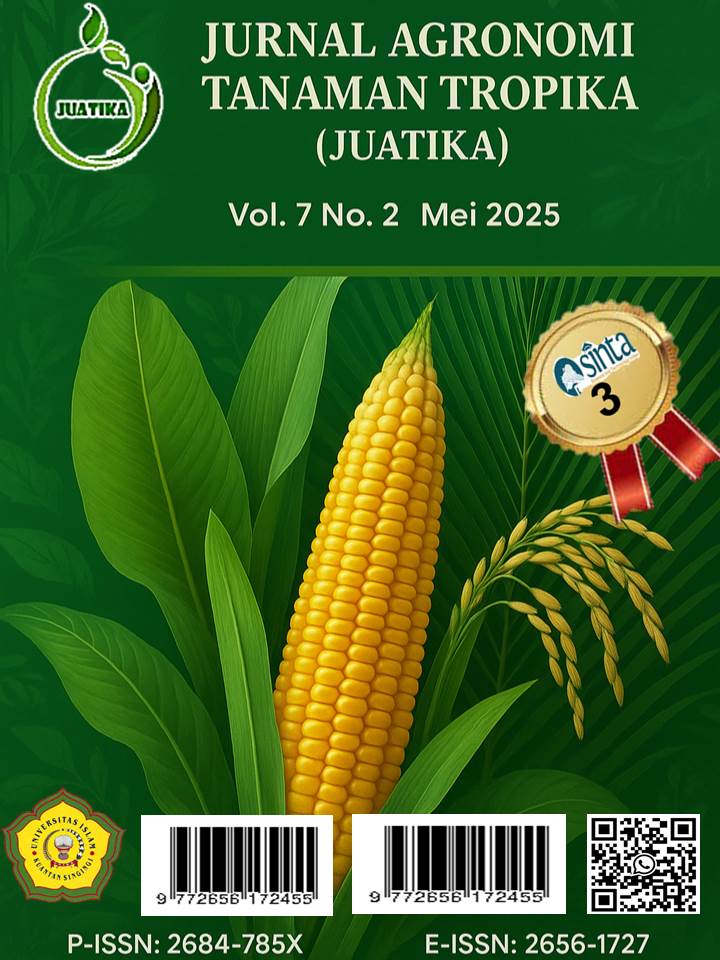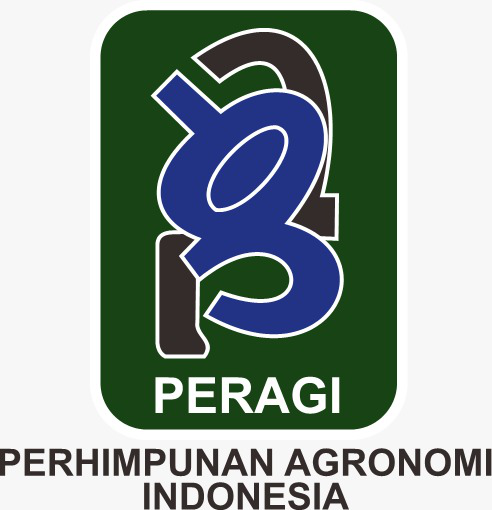Conservation of Murraya paniculata: Creating an Ideal Environment at the Biodiversity Conservation Center
Abstract
Murraya paniculata (Kemuning) is a highly valuable natural resource due to its ecological, aesthetic, and medicinal properties. However, its sustainability may be jeopardized by insufficient attention to plant conservation and environmental degradation. This study aims to evaluate the effects of various environmental factors on Murraya paniculata’s growth and determine the optimal conditions for its cultivation. The research was conducted using an experimental approach, observing ecological parameters such as soil pH, soil temperature, air temperature, soil moisture, and light intensity and analyzing their relationship to plant growth. The results indicated that Murraya paniculata thrives best in an environment with a soil pH of 6.5, a soil temperature of 29°C, an air temperature of 31°C, soil moisture categorized as humid, and normal light intensity. These ideal conditions promote increased plant height, improved leaf health, and enhanced growth.
Downloads
References
Barrow, N. J., & Hartemink, A. E. (2023). The effects of pH on nutrient availability depend on both soils and plants. Plant and Soil, 487(1–2), 21–37. https://doi.org/10.1007/s11104-023-05960-5
Chen, Y., Cao, N., Lv, H., Zeng, K., Yuan, J., Guo, X., Zhao, M., Tu, P., & Jiang, Y. (2020). Anti-inflammatory and cytotoxic carbazole alkaloids from Murraya kwangsiensis. Phytochemistry, 170, 112186. https://doi.org/10.1016/j.phytochem.2019.112186
Dosoky, N., Satyal, P., Gautam, T., & Setzer, W. (2016). Composition and biological activities of Murraya paniculata (L.) Jack essential oil from Nepal. Medicines, 3(1), 7. https://doi.org/10.3390/medicines3010007
FAO. (2004). Drought-resistant soils: Optimization of soil moisture for sustainable plant production. Food and Agriculture Organization of the United Nations.
Fascella, G., Montoneri, E., & Rouphael, Y. (2021). Biowaste-derived humic-like substances improve growth and quality of orange jasmine (Murraya paniculata L. Jacq.) plants in soilless potted culture. Resources, 10(8), 80. https://doi.org/10.3390/resources10080080
Fu, Z., Ciais, P., Wigneron, J.-P., Gentine, P., Feldman, A. F., Makowski, D., Viovy, N., Kemanian, A. R., Goll, D. S., Stoy, P. C., Prentice, I. C., Yakir, D., Liu, L., Ma, H., Li, X., Huang, Y., Yu, K., Zhu, P., Li, X., … Smith, W. K. (2024). Global critical soil moisture thresholds of plant water stress. Nature Communications, 15(1), 4826. https://doi.org/10.1038/s41467-024-49244-7
Gilman, E. F. (1999). Murraya paniculata. In Fact Sheet FPS (pp. 1–3). University of Florida.
Gómez-Bellot, M. J., Sánchez-Blanco, M. J., Lorente, B., Vicente-Colomer, M. J., & Ortuño, M. F. (2023). Effects of light intensity and water stress on growth, photosynthetic characteristics and plant survival of Cistus heterophyllus Desf. subsp. carthaginensis (Pau) M. B. Crespo & Mateo. Horticulturae, 9(8), 878. https://doi.org/10.3390/horticulturae9080878
Groppo, M., Afonso, L. F., & Pirani, J. R. (2022). A review of systematics studies in the citrus family (Rutaceae, Sapindales), with emphasis on American groups. Brazilian Journal of Botany, 45(1), 181–200. https://doi.org/10.1007/s40415-021-00784-y
Joshi, D., & Gohil, K. J. (2023). A brief review on Murraya paniculata (orange jasmine): Pharmacognosy, phytochemistry and ethanomedicinal uses. Journal of Pharmacopuncture, 26(1), 10–17. https://doi.org/10.3831/KPI.2023.26.1.10
Luo, H., Liu, S., Song, Y., Qin, T., Xiao, S., Li, W., Xu, L., & Zhou, X. (2024). Effects of waterlogging stress on root growth and soil nutrient loss of winter wheat at seedling stage. Agronomy, 14(6), 1247. https://doi.org/10.3390/agronomy14061247
Ma, X.-L., Zhu, S.-S., Liu, Y., Chen, H.-W., Shi, Y.-T., Zeng, K.-W., Tu, P.-F., & Jiang, Y. (2021). Carbazole alkaloids with potential cytotoxic activities targeted on PCK2 protein from Murraya microphylla. Bioorganic Chemistry, 114, 105113. https://doi.org/10.1016/j.bioorg.2021.105113
Mandal, S., Nayak, A., Kar, M., Banerjee, S. K., Das, A., Upadhyay, S. N., Singh, R. K., Banerji, A., & Banerji, J. (2010). Antidiarrhoeal activity of carbazole alkaloids from Murraya koenigii Spreng (Rutaceae) seeds. Fitoterapia, 81(1), 72–74. https://doi.org/10.1016/j.fitote.2009.08.016
Mishra, S., Spaccarotella, K., Gido, J., Samanta, I., & Chowdhary, G. (2023). Effects of heat stress on plant-nutrient relations: An update on nutrient uptake, transport, and assimilation. International Journal of Molecular Sciences, 24(21), 15670. https://doi.org/10.3390/ijms242115670
Msimbira, L. A., & Smith, D. L. (2020). The roles of plant growth promoting microbes in enhancing plant tolerance to acidity and alkalinity stresses. Frontiers in Sustainable Food Systems, 4. https://doi.org/10.3389/fsufs.2020.00106
Mukhopadhyay, S., Dutta, R., & Dhara, A. (2021). Assessment of air pollution tolerance index of Murraya paniculata (L.) Jack in Kolkata metro city, West Bengal, India. Urban Climate, 39, 100977. https://doi.org/10.1016/j.uclim.2021.100977
Neina, D. (2019). The role of soil pH in plant nutrition and soil remediation. Applied and Environmental Soil Science, 2019, 1–9. https://doi.org/10.1155/2019/5794869
Nparks. (n.d.). Murraya paniculata. Singapore Botanic Gardens.
POWO. (2023). Murraya paniculata (L.) Jack. Plants of the World Online Kew Science. https://powo.science.kew.org/taxon/urn:lsid:ipni.org:names:774441-1
Redhu, N. S., Thakur, Z., Yashveer, S., & Mor, P. (2022). Artificial intelligence: A way forward for agricultural sciences. In Bioinformatics in Agriculture: Next Generation Sequencing Era (pp. 641–668). https://doi.org/10.1016/B978-0-323-89778-5.00007-6
Rosenblatt, A. E., & Schmitz, O. J. (2016). Climate change, nutrition, and bottom-up and top-down food web processes. Trends in Ecology and Evolution, 31(12), 965–975. https://doi.org/10.1016/j.tree.2016.09.009
Safitri, R. N., Dayana, M. E., Annisa, V. C., Aulia, D., & Jumiarni, D. (2020). Pemanfaatan daun kemuning sebagai obat tradisional penyakit asma. PENDIPA Journal of Science Education, 4(3), 27–31. https://doi.org/10.33369/pendipa.4.3.27-31
Saqib, F., Ahmed, M. G., Janbaz, K. H., Dewanjee, S., Jaafar, H. Z., & Zia-Ul-Haq, M. (2015). Validation of ethnopharmacological uses of Murraya paniculata in disorders of diarrhea, asthma and hypertension. BMC Complementary and Alternative Medicine, 15(1), 319. https://doi.org/10.1186/s12906-015-0837-7
Seleiman, M. F., Al-Suhaibani, N., Ali, N., Akmal, M., Alotaibi, M., Refay, Y., Dindaroglu, T., Abdul-Wajid, H. H., & Battaglia, M. L. (2021). Drought stress impacts on plants and different approaches to alleviate its adverse effects. Plants, 10(2), 259. https://doi.org/10.3390/plants10020259
Shabrina, N. A., Maulana, Y., & Karyadi, B. (2024). Exploration of jaboticaba (Plinia cauliflora) cultivation in Bengkulu: Conservation in an optimized environment. JURNAL AGRONOMI TANAMAN TROPIKA (JUATIKA), 6(1). https://doi.org/10.36378/juatika.v6i1.3375
Swoczyna, T., Kalaji, H. M., Bussotti, F., Mojski, J., & Pollastrini, M. (2022). Environmental stress—what can we learn from chlorophyll a fluorescence analysis in woody plants? A review. Frontiers in Plant Science, 13. https://doi.org/10.3389/fpls.2022.1048582
Trimble, S. (2021). Transpiration in plants: Its importance and applications. CID Bio-Science.
Vasca-Zampir, D., Balan, D., Luta, G., Gherghina, E., & Tudor, V. C. (2019). Effect of fertilization regime on Murraya exotica plants growth and bioactive compounds. Romanian Biotechnological Letters, 24(2), 245–253. https://doi.org/10.25083/rbl/24.2/245.253
Wang, W., Li, B., Zhao, X., Zhang, S., & Li, J. (2025). Light intensity moderates photosynthesis by optimizing photosystem mechanisms under high VPD stress. Plant Physiology and Biochemistry, 218, 109322. https://doi.org/10.1016/J.PLAPHY.2024.109322
Wang, Y., Luo, Z., Zhao, X., Cao, H., Wang, L., Liu, S., Wang, C., WangWang, Liu, M., Wang, L., & Liu, Z. (2023). Superstar microRNA, miR156, involved in plant biological processes and stress response: A review. Scientia Horticulturae, 316. https://doi.org/10.1016/j.scienta.2023.112010
Wei, R., Ma, Q., Zhong, G., Su, Y., Yang, J., Wang, A., Ji, T., Guo, H., Wang, M., Jiang, P., & Wu, H. (2020). Structural characterization, hepatoprotective and antihyperlipidemic activities of alkaloid derivatives from Murraya koenigii. Phytochemistry Letters, 35, 135–140. https://doi.org/10.1016/j.phytol.2019.11.001
Wu, W., Chen, L., Liang, R., Huang, S., Li, X., Huang, B., Luo, H., Zhang, M., Wang, X., & Zhu, H. (2025). The role of light in regulating plant growth, development and sugar metabolism: A review. Frontiers in Plant Science, 15. https://doi.org/10.3389/fpls.2024.1507628
Yohanes, R., Harneti, D., Supratman, U., Fajriah, S., & Rudiana, T. (2023). Phytochemistry and biological activities of Murraya species. Molecules, 28(15), 5901. https://doi.org/10.3390/molecules28155901
Zhu, C., Lei, Z., & Luo, Y. (2015). Studies on antioxidative activities of methanol extract from Murraya paniculata. Food Science and Human Wellness, 4(3), 108–114. https://doi.org/10.1016/j.fshw.2015.07.001
Copyright (c) 2025 Mustika Elmi Dayana, Aceng Ruyani, Melda Nuari Handini, Hetti Yuliani Pohan

This work is licensed under a Creative Commons Attribution 4.0 International License.
Authors who publish with Jurnal Agronomi Tanaman Tropika (JUATIKA) agree to the following terms:
Authors retain copyright and grant the Jurnal Agronomi Tanaman Tropika (JUATIKA) right of first publication with the work simultaneously licensed under a Creative Commons Attribution License (CC BY 4.0) that allows others to share (copy and redistribute the material in any medium or format) and adapt (remix, transform, and build upon the material for any purpose, even commercially) with an acknowledgment of the work's authorship and initial publication in Jurnal Agronomi Tanaman Tropika (JUATIKA).
Authors are able to enter into separate, additional contractual arrangements for the non-exclusive distribution of the journal's published version of the work (e.g., post it to an institutional repository or publish it in a book), with an acknowledgment of its initial publication in Jurnal Agronomi Tanaman Tropika (JUATIKA). Authors are permitted and encouraged to post their work online (e.g., in institutional repositories or on their website) prior to and during the submission process, as it can lead to productive exchanges, as well as earlier and greater citation of published work.







 More Information
More Information



